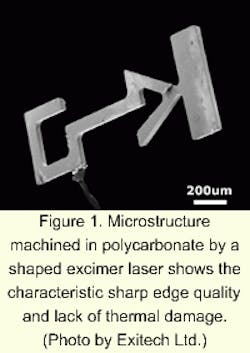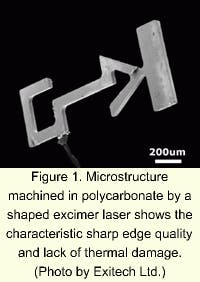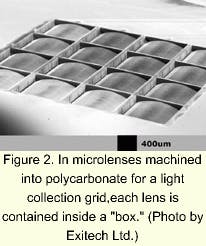Excimer lasers machine novel microstructures
Nadeem Rizvi
The high precision and flexibility that laser micro-machining techniques offer enable novel types of structures to be produced for emerging optical applications.Laser micromachining is currently used in a large number of R&D and industrial applications. The range of disciplines to which laser methods are being applied is constantly expanding and this is, in part, fueled by the developments in the processing techniques that allow novel microstructures to be produced. The range of available lasers also has increased and the modern product engineer has a dazzling choice of gas and solid-state lasers from which to choose.
Despite the new generation of compact, efficient, high repetition-rate solid-state lasers, excimer lasers continue to hold a key position in numerous sectors and continue to offer excellent quality of machining and great versatility in the types of features that can be produced.
Why excimer lasers?
Excimer lasers are gas lasers that emit pulses of light (Dt ~20 ns) in the ultraviolet (UV) region (see Laser Focus World, June 1992, p. 63). The two most commonly used excimer lasers are krypton fluoride (KrF) and argon fluoride (ArF), which emit light at wavelengths of 248 and 193 nm, respectively. These short pulses of UV light can be used for the efficient ablation of material to produce high quality microstructures (see inset).
The materials most commonly machined with excimer lasers include polymers (such as polyimide), ceramics (such as alumina), glasses (such as borosilicate), optical materials (such as CVD diamond), and thin films (such as oxides and coatings).
Excimer laser micromachining is usually carried out using mask projection methods. In this technique, the laser illuminates a mask (which contains a pattern) and a high-resolution lens projects the image of the mask onto the sample, thereby producing an imprint of the mask pattern in the material by laser ablation. The mask projection method allows production of a wide variety of features since the mask, laser, and sample can all be independently controlled and synchronized.1 Another feature of mask projection is that it can mimic direct writing techniques by projecting a circular beam for use as a cutting tool (see "The process of laser ablation," p. 78).
Optical applications
Many micro-optical-electromechanical systems (MOEMS) under development contain microstructures that cannot be made by conventional etching techniques, due either to material constraints or the shapes of the features themselves. The use of excimer laser machining allows such structures to be formed and therefore opens up new areas for the MOEMS designer.
Various "smart chip" devices for biomedical or chemical analysis combine alternative structures for the multifunctional elements that make up the system. These may include reservoirs, microchannels, positioners, valves, and optical structures. The control offered by excimer laser micromachining allows the size, depth, and quality of these features to be accurately implemented. Structures such as microlenses and blazed gratings are just two examples of typical features (see Figs. 2 and 3).
Another advantage of laser machining is that the structure can be made directly onto the final device without intermediate steps. In the case of antireflection (AR) structures, for example, micron-dimension features on the surface of an optical element act like an AR coating, and the ability to machine the optical material directly avoids the problems associated with optical coatingssuch as lifetime, refractive index mismatches, and damage threshold (see Laser Focus World, August 1999, p. 109).
The use of laser ablation to machine optical structures does not always produce a surface roughness that is low enough for all applicationsthe surface roughness is heavily dependent on the material, laser wavelength, and method of processing. In many light-gathering or light-guiding applications, however, it is not necessary to have a very high quality optical finish, so the types of results shown in figures 2 and 3 are perfectly acceptable. In some applications, such as the processing of optical elements in diamond, laser micromachining may be used to produce almost the correct optical figure before a final conventional polishing step is used to achieve the desired finish.
Optical fibers
The explosive rise in Internet traffic and optical communications in the past few years has led to novel and, in some cases, quite stringent demands being placed on laser processing of optical fibers. The diversity and production volumes of fiber-based devices are growing at astonishing rates but the manufacture of in-fiber optical gratingsfiber Bragg gratings (FBGs)still remains the central product. Different companies have adopted various production routes for FBGs but the excimer laser currently remains one of the key laser options (the other one being the argon-ion laser). Although FBGs cannot strictly be regarded as micromachined structures, there are other structures in optical fiber devices that also need to be produced and that can benefit from excimer laser micromachining.
One of the initial steps in the laser writing of FBGs is the stripping away of a length of the plastic coating that protects the fiber cladding and core. This is normally done mechanically and/or chemically just prior to the laser exposure. Stripped fiber is, however, very prone to damage or breaking and so the exposed fiber usually needs to be sealed or packaged in some way after the FBG has been written. This is both time-consuming and expensive. The process of stripping, itself, also can cause microcracks or strains in the fiber, which are undesirable. Laser stripping is therefore an attractive option and excimer lasers can ablate the coating cleanly without affecting the cladding or core (which are made of fused silica and have minimal absorption in the UV).
Figure 4. The plastic sleeving of an optical fiber can be machined with an excimer laser so that gratings can be written. The entire coating can be stripped (top) or a slot can be produced (bottom). The length and width of the slot can be easily changed to suit the size of fiber Bragg grating being produced. (Photo by Exitech Ltd.)
An alternative to the stripping of the fiber is the selective removal of a slot in the fiber through which the FBG can be written. The advantage of this is that the bulk of the protective sleeving remains in place and so protects the fiber from unnecessary stresses. It may still be desirable to package the fiber after the FBG has been written, but at least the more risky process of the complete removal of the protective layer can be avoided (see Fig. 4).
Another requirement that also can be met using excimer lasers is the permanent coding of optical fiber products with an identification mark (see Fig. 5).
The attraction of stripping, FBG writing, and coding of optical fibers with excimer lasers is that it allows the use of a single laser tool for the whole operation. Particularly with growing production demands from the telecommunications industry, an automated laser processing system could provide a major economic and technical benefit.
REFERENCE
- N. Rizvi, Proc. SPIE, 3898, 240 (1999).
Nadeem Rizvi is principal development engineer at Exitech Limited, Hanborough Park, Oxford OX8 8LH, England; e-mail [email protected]
The process of laser ablation
The basic process of ablation is as follows:
- Laser light is absorbed by the material.
- UV photons break molecular bonds in the sample.
- The particle number density increases rapidly as more bonds are broken, which leads to an increase in pressure.
- The pressure build-up results in an explosive ejection of material.
The choice of which laser to use depends largely on the material that has to be micromachined.* The laser wavelength is selected to ensure sufficient absorption in the material so that a strong interaction occurs. Most polymers, for example, have very high absorption in the ultraviolet and so machine well with excimer lasers.
- This does not apply to recent developments in machining with ultrashort laser pulses (see Laser Focus World, April 2000, p. 73).


